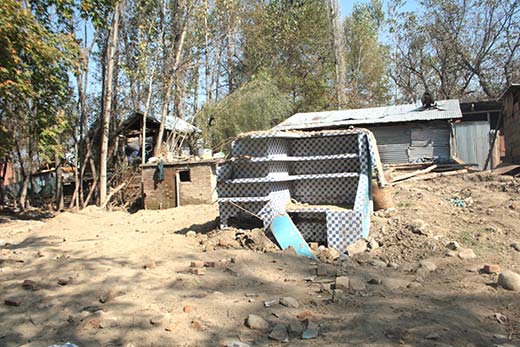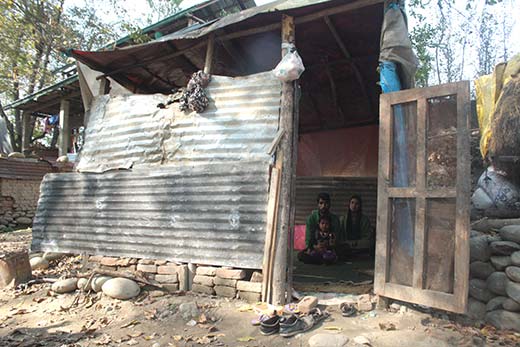On the banks of Veshaw, flood-devastated Aarigatnoo hamlet is gradually reviving its existence. Bilal Handoo visits the village in fall, winter and spring to report rebuilding

Fall 2014
It is October 2014 and houses are scattered on the road in Kulgam’s Aarigatnoo village — as if packs of cards. Amid ruins emanate ruckus. Villagers gathered in small groups are fiercely arguing for help.
Nearby, a horde of villagers are running behind a small lorry arriving in the village with relief material.
These are desperate scenes. Men, women and children are out on road. A different agitation is building up. It is stir for survival. A month ago, no villager perhaps had a hunch that life for them would be akin to a destitute with the fall of 2014.
Everything was fine in Aarigatnoo before Veshaw — a tributary of Jhelum having a serpentine pass through the village — couldn’t contain its roaring waters, went berserk and flooded the entire village in first week of September 2014. A week later, 98 per cent of village’s population had become homeless.
Residents are now living inside makeshift tents pitched on road alongside rubble. But not every villager has turned up to behold the scenes of devastation. Those who returned have been apparently left distressed by noticing their cattle missing, their orchards uprooted and their homes, packed with prized possessions, turned into debris.
Presently gripped with gloom, Aarigatnoo is all about tragic flood tales. They are on everyone’s lips. Characters are different but not the story line. And once villagers start recounting them, a hue of grey seems to drape the entire village.
Away from roadside crowd and past the uprooted trees, there exist even more stark signs of flood destruction. Some kitchens are half-standing, half-torn. Clothes washed away by floods are hung on tree branches. Books and bags are buried under mud.
Close by, some villagers are hammering the wood and tin to make sheds for living. “That patch of land buried under bricks and mud used to be my home a month ago,” says a skinny man, pointing to a nearby rubble.
Introducing himself as Bashir Mir, the man is working as special police official who happens to be one of the witnesses of flood. For almost the entire week, he remained trapped inside village mosque. “Veshaw started flooding the village by breaching its bunds at three different sides with the start of September,” he says.
Both pace and volume of Veshaw frightened the villagers to an extent that they left behind everything and ran away. But Bashir and some handful of villagers stayed put only to witness the rampaging run of the water body.
Through the mosque window, Bashir saw Veshaw washing away utensils, cattle, logs, roofs and many other things. “At that point of time, I thought my end is near now,” he says. What instilled a sense of fear in him were the sudden and frequent sounds of house collapse. But he hardly knew that one of the sounds he heard then was that of his own collapsing house.
But his nightmare ended after Veshaw calmed down four days after unleashing the worst violence over the village. It took him another three days to step out of the mosque and see the doomed village. He waded in knee-deep water to take stock of his house and saw it reduced to rubble. But he wasn’t only one to witness such scenes.
Like Bashir, there is Fatima, a mother of three kids, presently having no secure roof over her head. She too lost everything in floods.
Staring vaguely at her three children playing nearby with other village kids, she seems badly disturbed. “Winter is approaching very fast,” she speaks almost in a defeated voice. “How shall I survive with my kids inside this shed?”
This question has already started sending shivers down the villagers’ spine. However the answer, on face of paltry government compensation, is eluding everyone. “There is only one way to survive in winter,” says Rahim Khan, an elder puffing Hookah inside one of the scanty sheds, “we may have to live like parasites at our relatives’ residence.” Keeping the sluggish pace of village rebuilding in view, it seems villagers haven’t much choice than to live what Khan says like “parasites”.
Winter 2015
It is shivering day of January 2015, and mist has wrapped Aaringatnoo. Much of the wreck on road has been cleared now. Unlike October last year, there are no signs of desperation around. No relief loaded lorries make their presence felt in the village anymore. And with winter, the makeshift tents pitched on roads too have gone.
What has remained though are sheds and inside them — the shivering souls holding kangris close to their bodies. “It is getting harder to survive amid this chill,” says Fatima, stuffed with shabby and perforated pheran, continues to live inside shed. Her husband, a labourer, has left to find some work at busy Kulgam market—about 3 kms from the village.

Pic: Bilal Handoo
Since October, many new houses have dotted the devastated landscape of Aarigatnoo. But most of these houses still lack proper windows, doors and roofs. Some have covered their windows with rags, others with bed-sheets and a few with polythene.
“To escape winter,” says Mushtaq Bhat, a tall villager, probably in his mid-thirties, “many villagers have left to live with their relatives.”
Amid desolation and devastation, hope still rekindles in the village. Construction material is still pouring. Chill is not damping the spirit to provide facelift to this flood-torn village. Hammers, shovels and other construction tools are still at work — and sluggishly paving way to rebuilding.
But the ironic reality of Aaringantoo remains: not everyone is on the same pedestal here. Some 2000 souls populating this village suffered alike, but not everyone is resourceful to brisk with rebuilding. This is the reason why scores of sheds still cradle life amid this bitter cold. “And those who couldn’t bear the chill have left to live with their relatives in neighbouring villages,” Bhat says.
Spending winters at relatives’ residence has more to it than a supposed ‘chill factor’. Among those huddled inside the sparse sheds are daughters of this village.
“Can you imagine a family with eight members, including daughters living inside a shed?” asks Feroz Ali, a teacher in the village. “It is indeed very hard and harsh life to say the least.” Besides, Ali continues, why should parents take a risk by housing their daughters inside such insecure shed? “Though the entire village is like one big family, but then one can’t rule out risks.” Perhaps, the same sense of insecurity compelled people like Rahim Khan to live like a “parasite” with his relatives.
Spring 2015
Just like in Srinagar, it is soaked April day in Aarigatnoo. Some of the fields layered with slush and dirt in October last year are now blooming with mustards. Vibrant colours have spread a golden hue over the village—above which the sky is still forecasted. Amid spring shower, breeze and vibrancy, the village is limping back to rebuilding mode.
Rahim Khan is back, so is Bashir Mir after a wintry sojourn at their respective relatives. Both are clearing the debris. They say, ‘proper’ compensation still eludes them. “But then we can’t wait for govt till eternity,” Mir says, suspending his work for a while. “We had to borrow money, take loans and sell our land to raise finance for rebuilding our houses.”
But not everyone had has a fall back system to rely on. There is Fatima’s family — still dwelling inside a shed, living hand to mouth. For her, rebuilding is a distant dream, unless, yes, someone comes to her rescue.
She isn’t alone though. There is Hajira, Kulsum, Ruqaya, Zainab… Each one of them has the similar fate — and each one of them awaiting any possible help.
“Had the floods only affected selected ones,” says Tariq Ahmad, a villager, “the rest of the village would have raised funds for them.” But, he says, none escaped the fury of floods. “And therefore, those with least pocket strength are bound to suffer more in want of resources for rehabilitation.” State government’s ‘indifference’, he says, has further compounded their problems.
After witnessing sluggish pace in fall and winter, the village’s rebuilding seems to have a paddling shift in spring. In between, the power centre too has shifted in state — the reigns of which lied with Omar Abdullah in fall, NN Vohra in winter and Mufti Muhammad Sayeed in spring. Amid all this, the village on banks of Veshaw is still awaiting its moment of spring.















